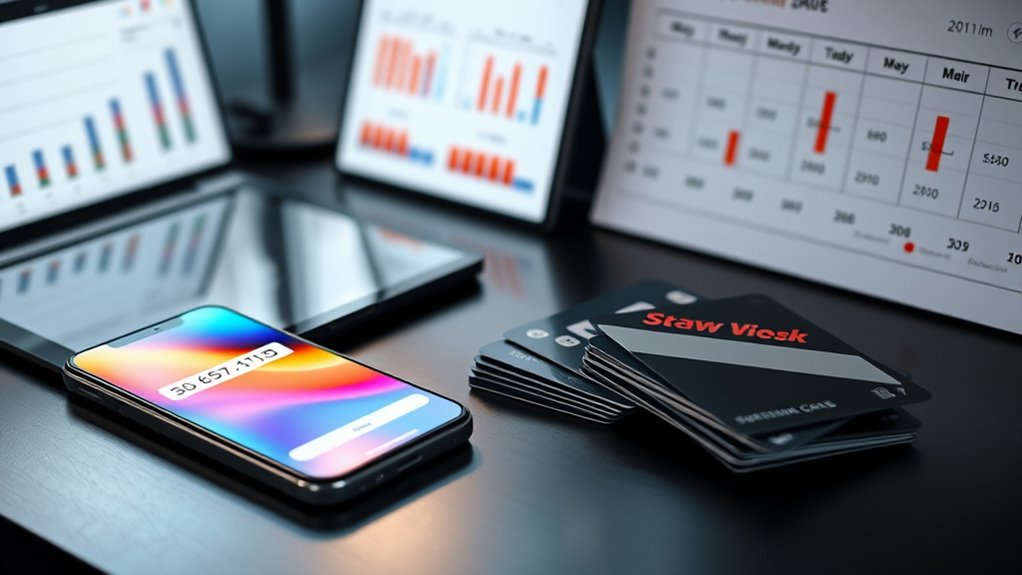Recurring payments allow you to automatically bill customers at regular intervals, like weekly, monthly, or yearly. You provide payment details once, and the system charges customers automatically on scheduled dates, ensuring continuous access to your service. This setup reduces manual effort, minimizes missed payments, and offers predictable revenue. Handling upgrades, plan changes, and failed transactions requires careful management. Keep exploring to uncover more about how this seamless system can boost your business.
Key Takeaways
- Subscription billing automatically charges customers at regular intervals using stored payment details.
- It supports various plans, including fixed, usage-based, and tiered pricing models.
- Customers can often cancel or modify subscriptions anytime, with some plans having contractual commitments.
- Payment failures are managed through retries and notifications to minimize disruptions.
- Automation reduces manual effort, ensures continuous access, and delivers predictable revenue for businesses.

Recurring payments are a streamlined way to handle ongoing transactions by automatically deducting funds from your account at set intervals. When you sign up for a service with recurring billing, you typically provide your payment information once. After that, the system authorizes automatic charges at intervals like weekly, monthly, quarterly, or annually, depending on your agreement. This setup means you don’t have to manually approve each payment, making the process smooth and hassle-free for both you and the business. The payment schedule and amount are predefined, guaranteeing your access continues without interruption.
Recurring payments automatically deduct funds at set intervals, ensuring seamless access without manual approval.
This system is common across industries such as SaaS, streaming platforms, fitness clubs, e-commerce, and publications. You might pay a fixed amount every cycle, or the amount can vary based on your usage or plan. For example, a streaming service might charge a set monthly fee, while a utility app could bill you based on your consumption. Once you’ve authorized the initial payment, the billing platform securely stores your details and automatically triggers charges on each billing date. This automation eliminates the need for manual payments, saving you time and reducing the risk of missed payments.
Recurring payments are the simplest form of subscription billing. They involve straightforward, repeated charges of a fixed amount. In contrast, subscription billing can offer more flexibility, such as tiered plans, free trials, upgrades, downgrades, and specific cancellation policies. While recurring payments typically allow you to cancel at any time, some subscription plans may include contractual commitments or penalties for early termination. Managing subscriptions involves more than just billing; it includes handling different plan options, customer upgrades, and pricing adjustments.
One significant benefit of recurring payments is the convenience they provide. They automate the billing process, ensuring you never forget a payment and maintaining uninterrupted access to services. For businesses, recurring billing offers predictable revenue streams, simplifying financial planning and forecasting. It also reduces administrative overhead, lowering costs associated with invoicing and manual collection efforts. Additionally, it fosters customer loyalty by creating ongoing relationships and makes it easier for businesses to promote upgrades or plan changes, boosting revenue growth. Implementing automatic billing can also improve cash flow stability for companies.
However, challenges exist. Payment failures, often caused by expired or outdated credit cards, can disrupt service and lead to revenue loss. To address this, many companies use strategies like dunning—automatic retries combined with customer notifications—to recover failed payments. Strong security protocols and PCI compliance are essential to protect sensitive payment data and build trust. Variable charges or usage-based billing can introduce complexity, requiring precise management to ensure accuracy and customer satisfaction. Implementing effective payment recovery strategies can help minimize revenue loss. Balancing automated billing efficiency with customer retention efforts is key to maintaining a healthy revenue stream and positive customer experience.
Frequently Asked Questions
How Do I Cancel a Subscription Before the Next Billing Cycle?
To cancel your subscription before the next billing cycle, you need to act early, ideally before the current cycle ends. Log into the platform where you signed up—like Apple, Google Play, or Stripe—and navigate to your account or subscriptions section. Choose the cancel option, and if available, select to cancel before the next billing date. This way, you prevent the upcoming charge and retain access until the current period ends.
What Security Measures Protect My Payment Information During Recurring Transactions?
Did you know that over 80% of data breaches target payment information? During recurring transactions, your payment data stays protected through encryption protocols like TLS, which scramble your info during transmission. Plus, tokenization replaces sensitive details with secure tokens, making theft useless. Multi-factor authentication and real-time fraud monitoring further keep your info safe, ensuring your payments are secure without needing to worry about unauthorized access.
Can I Change My Subscription Plan After Signing Up?
Yes, you can change your subscription plan after signing up. Most services let you upgrade or downgrade through their website or app. You might need to cancel your current plan first or the change could be immediate. Keep in mind, billing cycles may adjust, and you might get prorated charges or refunds. Always review the new plan’s terms to confirm it fits your needs before making changes.
How Are Failed Payments Handled and What Are the Recovery Options?
When your payment fails, the system typically retries automatically with scheduled attempts. You’ll receive notifications asking you to update your billing info, and using multiple payment methods can boost success. If you don’t update details, the subscription might be paused or canceled. To recover payments, businesses often employ retry logic, send reminders, and use platforms that streamline payment recovery, helping you stay subscribed and avoid interruptions.
Are There Any Fees for Pausing or Resuming a Subscription?
You’re wondering if there are fees for pausing or resuming a subscription. Typically, platforms like GoCardless, PayPal, Stripe, and Google Play don’t charge extra for these actions, so you can pause or resume without additional costs. However, any pending payments before the pause still need processing, and resuming might trigger standard billing or retry fees if payments fail. Check your provider’s policies for specific details.
Conclusion
Now that you’ve uncovered the mysteries of subscription billing, you’re ready to navigate recurring payments with confidence. Remember, it’s like having a trusty steed—steady and reliable—whether you’re managing a business or just enjoying your favorite streaming service. Don’t let the complexities make you feel like you’re stuck in a science fiction flick. With this knowledge, you’re all set to master the art of seamless recurring payments—no flux capacitor required!









